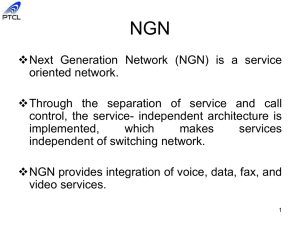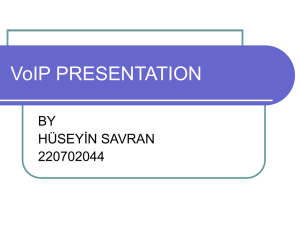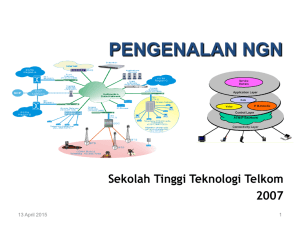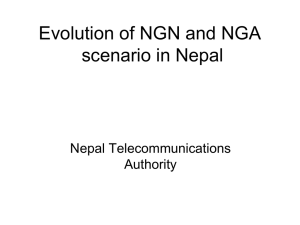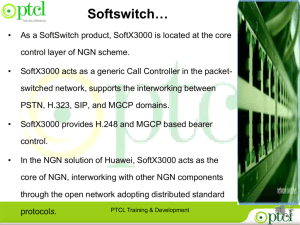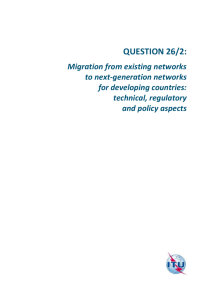IPTax_project
advertisement
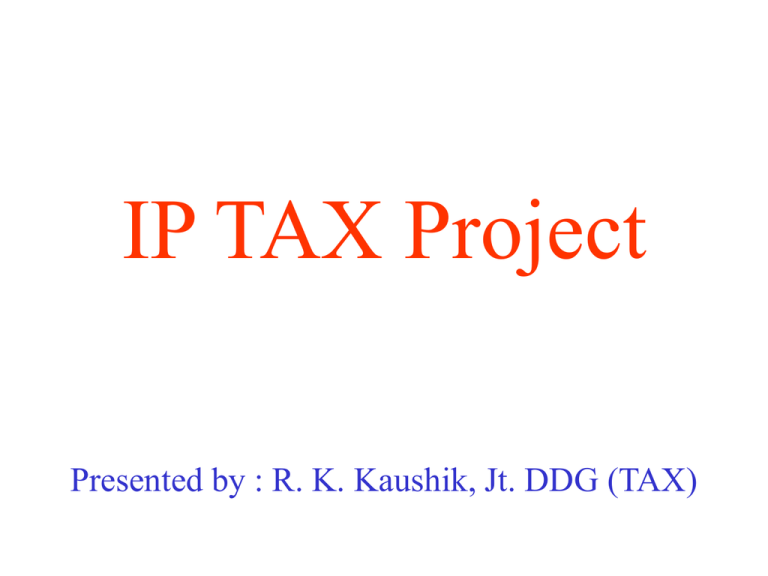
IP TAX Project Presented by : R. K. Kaushik, Jt. DDG (TAX) NGN Concept Service / Application Layer Control Layer Transport Layer Access Layer Each vertical on the left has to be split into Network Elements that map onto horizontals on the right NGN Concept Service / Application Layer Application Layer Transport Layer Access Layer PLMN PSTN Circuit to Packet migration is first step in mapping of PSTN to NGN NGN – ITU Perspective • Next Generation Network (NGN) provides a framework for network evolution, as defined by the ITU-T (Rec. Y.2001) • Key Characteristics – Packet-based network [generally Internet Protocol or IP] – Independence of service-related functions from underlying transport technologies – Interworking with legacy networks via open interfaces – Generalized mobility – Unrestricted access by users to different services and/or service providers ETSI NGN Vision • Mobile/Fixed Convergence, based on the “IMS” platform • A multi-service, multi-protocol, multi-access, IP based network - secure, reliable and trusted • Multi-services: delivered by a common QoS enabled core network. • Multi-access: diverse connectivity networks; fixed and mobile terminals, (Mobile, xDSL, etc) • Not one network, but different networks that interoperate seamlessly • Mobility of both users and devices • “My communications services” – anywhere, any terminal >>> all of this leads to a true Next Generation Network The Vendor’s Perspective • Mobile: Motorola, NEC, Nokia, Samsung • Fixed: Cisco, Italtel, Sonus, Tekelec, Veraz • Mobile/Fixed: Alcatel, Ericsson, Siemens, Huawei, UTStarcom • Fixed/Mobile: Lucent, Nortel • Mobile/Fixed and Mobile are leaders in Session Management • Fixed and Fixed/Mobile are leading with MGCF PSTN to NGN Migration BSNL Perspective PSTN to NGN PSTN Switch NGN Components Call Control Call Server / Soft Switch Switching Routers of IP/MPLS Network Interfaces TDM Transport Network Gateways Common IP MPLS Transport SG / TMG / LAG Softswitch Announcement Server Signaling Gateway IP MPLS Core Network STP Network Trunk Media Gateway PSTN Switch Step- 1: IP TAX – Class 4 NGN GENERIC REFERENCE DIAGRAM FOR ‘IP BASED TAX’ SG 1,2 Sigtran / SCTP NMS Sigtran / SCTP Softswitch (MGC) Softswitch (MGC) SIP-T SG 1,2 Q.1912.5 SS7 SS7 ANNOUNCEMENT SERVER ANNOUNCEMENT SERVER H.248 STP Function STP Function H.248 SS7 NTP SERVER CORE IP BACKBONE NETWORK SS7 PSTN PSTN Bearer Channels Bearer Channels MG MG IP/RTP Scope of IP TAX Project • Setting up Two Soft Switches at New Delhi and Chennai and Signalling Gateways at New Delhi, Chennai, Kolkotta and Bangalore • Providing Trunk Media Gateways (TMGs) at 21 Level-1 locations • Providing one Announcement Servers in each IP domain • Billing interface to Centralized Billing Server • NMS IP TAX Components • Soft Switch (or Call Agent or Telephony Server or Media Gateway Controller) – Based upon Open Architecture – Should preferably be developed on Commercially Available Hardware and Software Platforms – Should be able to provide all existing services available in TDM network – Performs Media Gateway Control Function – Performs Call control, signalling and interworking, Traffic measurement and recording functions – Provides Addressing, Analysis, routing and charging facilities – Interacts with Application Server to supply services not hosted on Softswitch IP TAX Components • Signalling Gateway – Provides interworking function between SS7 network and IP network • This involves providing various types of User Adaptations so that the SS7 signalling can be terminated in SGW and can be translated and messages transported over IP Network – Performs Packetization of signalling and ensures its transport through IP network IP TAX Components • Trunk Media Gateway – Performs the functions of • • • • • • Voice encoding & Compression Packetization of voice channels CNF (Comfort Noise Generation) VAD (Voice Activity Detection) Echo Cancellation May provide the edge functionality and act as CE NMS New Delhi AG -4 JLN -4 ND 40 JPR -4 AM -4 AS 0 Soft switch (MGC) EMS RJ -4 MG SG PT - 8 MG MG MG LW 4 MG MG MG GU - 4 BSNL’s MPLS Core MG MG MG AHM -8 MG RPR - 4 MG MG BPL -4 MG MG MG MBI - 40 MG NGP – 4 MG MG CBT - 4 MG CHN - 16 MG BG 12 ENK - 4 CK - 4 Chennai Soft switch (MGC) AS EMS KOL - 16 SG HYD -8 Existing STP N/w Future IP TAX Requirement UNIT AN AP AS BH CHG ETR GJ HP HR JK JKD KRL KT MH MP NE-I NE-II NTR OR PB RJ STR TN UCHL UPE UPW WB W TR Gra nd Tota l TAX Ca pa city Re quire d (in KC) 10.0 358.0 64.0 213.0 50.0 533.0 391.0 110.5 87.0 43.5 150.0 523.0 329.5 327.0 259.5 22.0 74.0 360.0 139.5 248.5 322.5 667.5 504.5 34.0 330.0 42.5 89.5 192.0 6,476 Soft Signa lling Sw itche s Ga te w a ys 1.0 3.0 1.0 2.0 1.0 4.0 3.0 1.0 1.0 1.0 1.0 4.0 3.0 3.0 2.0 1.0 1.0 3.0 1.0 2.0 3.0 5.0 4.0 1.0 3.0 1.0 1.0 2.0 59.0 1.0 5.0 1.0 3.0 1.0 7.0 5.0 2.0 2.0 1.0 2.0 7.0 5.0 5.0 4.0 1.0 1.0 5.0 2.0 4.0 5.0 9.0 7.0 1.0 5.0 1.0 2.0 3.0 97.0 MGW s 1.0 18.0 4.0 11.0 3.0 27.0 20.0 6.0 5.0 3.0 8.0 27.0 17.0 17.0 13.0 2.0 4.0 18.0 7.0 13.0 17.0 34.0 26.0 2.0 17.0 3.0 5.0 10.0 338.0 Application Servers Announcement / Media Server Other VoIP Network Signaling Gateway IP MPLS Core Network Session Border Controller Customer Network Step 2: Softswitch STP Network Trunk Media Gateway PSTN Switch Access Network Line / Access Gateway IP TAX and Access in NGN Class 5 Components • Application Server (or Feature Server) – Provides service logic and execution of user (or customer) services that are not directly hosted on Softswitch – Due to open architecture and standards it can be a third party product Class 5 Components • Session Border Controller (SBC) – Deployed at edge (IP-IP network border as between service provider and customer / enterprise network) and core (IP-IP network border as between two service providers) of service provider’s network to control signaling and media streams as they enter / exit the network – Provides security, denial of service attacks, overload control, Network Address Translation and Firewall Traversal, Lawful Interception, QoS management, Protocol Translation, call accounting Class 5 Components • Access Gateway – Performs the functions of • Media conversion • Codec Negotiation • Termination of line side interfaces like phones, devices and PBXs • Echo Cancellation • VAD (Voice Activity Detection and Comfort Noise Generation) • Providing edge functionality and act as CE router Next Generation Switching Architecture Application Server Soft switch SBC PRI Line Access Gateway Access Gateway SHDSL V5.2 Common IP MPLS Transport RSU 2B+D ADSL/ADSL2+ AN TMG E1s SSTP Network Local / Rural Exchanges NGN Definition • ITU-T definition for NGN: – A Next Generation Network (NGN) is a packetbased network able to provide services including Telecommunication Services and able to make use of multiple broadband, QoS-enabled transport technologies and in which service-related functions are independent from underlying transport-related technologies. It offers unrestricted access by users to different service providers. It supports generalized mobility which will allow consistent and ubiquitous provision of services to users Step 3: Fully Converged Architecture IMS Architecture IMS Key Components Network Function Role Origin Call Session Control Function (CSCF) Handles registration of end points, routing of SIP signaling messages SIP Proxy Servers, Developed from scratch Home Subscriber Server (HSS) One-stop database for user information HLR from mobile network Media Gateway Control Function (MGCF) Softswitch Media Gateway Control Softswitch Application Server (AS) Provide service logic for applications Feature Servers, Feature sets from Softswitches Policy Decision Function (PDF) Provides QoS Existing Policy Managers, from scratch Migration Path to IMS E T S I’s M ig ra tio n P a th to IM S S te p 1 – T e le p h o n y S o ftsw itc h s o lu tio n In tro d u c tio n T e le p h o n y S o fts w itc h e s • C o s t re d u c tio n th ro u g h th e m o d e rn iza tio n o f th e a g e in g c irc u it s witc h e d n e tw o rk . • S e p a ra te s c a ll c o n tro l fro m c o n n e c tiv ity • L o w e rs C A P E X a n d O P E X S te p 2 – S o ftsw itc h / IM S s o lu tio n R o ll o u t o f IM S • In tro d u c e s IM S a lo n g s id e S o fts witc h • A llo ws in tro d u c tio n o f n e w S IP b a s e d s e rv ic e s • In c re a s e s s e rv ic es rev e n u e s a n d c us to m e r b a s e S te p 3 – F u ll IM S te le p h o n y s o lu tio n In tro d u c tio n o f IM S A c c e s s G a te w a y s • S o fts witc h e s u p g ra d e d to te le p h o n y s e rv e rs to e n a b le fu ll -IM S • In tro d u c tio n o f IM S te le p h o n y g ra d u a lly to re p la c e le g a c y 25 THANK YOU NGN Class 5 Features – Mobility: It should be possible for users to register dynamically their current location so that they can be contacted when mobile using a publicized address – Forking: It should be possible to associate multiple devices with a single address, so that all or a selection of these devices can be contacted simultaneously or in succession – Features Negotiation: It should be possible for the users to negotiate media and protocol extensions to be used for a particular call for setting up any type of media conversation, including voice, video and messaging NGN Class 5 Features – Applications Flexibility: It should be possible to define, create and implement new applications in the network. The new applications may be built up on separate Application Servers which may be located in the same network / domain or in some other network / domain. The addition of new applications will normally not require changes in any of the devices, other than hosts, in the transport network – Combinational services: It should be possible to combine different services into one service e.g., instant messaging and voice Comparison Soft Switch IMS - Small step - Yields IP cost advantages - Easily supports current PSTN services - Makes use of Intelligent Network (IN) services - Big step - Yields IP cost advantages - Does not as easily support current PSTN services - Does not use IN - Platform for non PSTN services - Achieves fixed & mobile core network convergence. Circuit Switching (CAS) Transit Local Exchange Call Control Switching Call Control Switching Local Exchange Signaling & Bearer Interfaces Call Control Signaling & Bearer Switching Interfaces Interfaces Bearer is a voice channel Circuit Switching (CCS) Transit Local Exchange Call Control Switching Call Control Bearer Switching Interfaces Local Exchange Call Control Bearer Interfaces Switching Interfaces Call Control Switching Signaling Signaling Interfaces STP Circuit Switching (CCS) Transit Local Exchange Call Control Switching Call Control Bearer Switching Local Exchange Call Control Bearer Interfaces Switching Interfaces Interfaces Signaling Signaling Transfer Signaling Circuit Switching (CCS) Transit Local Exchange Local Exchange Call Control Call Control Call Control Bearer Switching Bearer Transfer Bearer Switching Interfaces Interfaces Signaling Signaling Transfer Signaling Soft Switching Transit Architecture Transit Local Exchange Local Exchange Soft switch Call Control Call Control Gateway Gateway Bearer Switching Switching Bearer Common IP MPLS Transport Interfaces Signaling Interfaces Gateway Gateway Signaling Next Generation Switching Transit Local Exchange Soft switch Call Control Gateway Bearer Gateway Switching Common IP MPLS Transport Interfaces Gateway Signaling When 3G and MPLS core are available Transit Option-I Local Exchange GSM Network 3G Call Control Bearer Switching Signaling Common IP MPLS Transport Interfaces When 3G and MPLS core are available Transit Option-II (Preferred Solution) Local Exchange Soft switch GSM Network 3G Call Control TMG Bearer Switching Common IP MPLS Transport Interfaces SGW Signaling IMS Architecture Overview of NMS Site - Chennai NMS SSW Local Terminals FE FE Billing System LAN SW SGW Gig-E AS PLMN TMG PSTN E1/STM-1 FE STP PSTN/PLMN Gig-E MPLS Edge Overview of Soft Switch Site - New Delhi Remote NMS Terminals SSW FE AS PLMN FE LAN SW SGW TMG Gig-E PSTN E1/STM-1 FE STP PSTN/PLMN Gig-E MPLS Edge Overview of SGW Site – Bangalore & Kolkatta Remote NMS Terminals PLMN LAN SW SGW TMG Gig-E PSTN E1/STM-1 FE STP PSTN/PLMN Gig-E MPLS Edge Overview of Other 16 Level-I Sites Remote NMS Terminals PLMN LAN SW TMG Gig-E Gig-E PSTN E1/STM-1 MPLS Edge EOI EOI for NGN Project • The TAX requirement for next two years is about 6.5 million circuits • Tender for deployment of 200 KC IP TAX is under evaluation • EOI is being floated for inviting bidders to get their equipment validated • Successful bidders in EOI will become eligible to participate in the future requirement of 6.5 million DS0s EOI for NGN Project • The EOI is for both IP TAX(Class 4) and Access Network (Class 5) • The EOI envisages validation for three types of Configurations viz.,: – a) Configuration 1.0 (IP-TAX) – b) Configuration 2.0 (Access Network) – c) Configuration 3.0 (Application Services) • Validation Certificates are proposed to be issued for each configuration Equipment for Configuration 1.0 S# Equipment Qty 1 Soft Switch 2 2 Trunk Media Gateway 4 3 Signaling Gateway 4 4 LAN Switch 1 5 Announcement / Media Server 2 6 Equipment for Billing System Interface 1 Remarks At least one Media Gateway of each category (B, C, D, E) Equipment for Configuration 2.0 S# Equipment Qty Remarks 1 Soft Switch 2 2 Trunk Media Gateway 4 At least one Media Gateway of each category (B, C, D, E) 3 Line Access Gateway 2 At least one Line Access Gateway of each type (Type-I and Type-II) 4 Access Gateway 2 At least one Access Gateway of each type (Type-I and Type-II) 5 Session Border Controller 1 6 Signaling Gateway 4 7 LAN Switch 1 8 Announcement / Media Server 2 9 Soft Phones 10 10 SIP Phones 20 11 IADs 5 12 Equipment for Billing System Interface 1 Equipment for Configuration 3.0 S# Equipment Remarks 1 SIP Proxy Server 2 SIP Registrar 3 Redirection Server The functions normally assigned to the equipment shown here may be performed by separate or a combination of servers. The servers may also have nomenclature and philosophy, which is different from that shown here. Services Requested • • • • • • • • • • • • • • • • Caller ID related services (CLIP, CLIR, ...) Call waiting, Call holding, Push to talk Call forwarding, Call transfer Follow me service Call blocking services, Malicious Caller Identification Click to Dial Musical Ring Back Lawful interception Announcement services Conference call services Voicemail, Text-to-speech, Speech-to-text SMS, MMS IP Centrex Calling Card Pay Phone Carrier Selection • Presence information, Instant messaging Additional Features in Configuration 3.0 • Offered services shall have the following features: – Mobility: It should be possible for users to register dynamically their current location so that they can be contacted when mobile using a publicized address – Forking: It should be possible to associate multiple devices with a single address, so that all or a selection of these devices can be contacted simultaneously or in succession – Features Negotiation: It should be possible for the users to negotiate media and protocol extensions to be used for a particular call for setting up any type of media conversation, including voice, video and messaging Additional Features in Configuration 3.0 • Offered services shall have the following features: – Applications Flexibility: It should be possible to define, create and implement new applications in the network. The new applications may be built up on separate Application Servers which may be located in the same network / domain or in some other network / domain. The addition of new applications will normally not require changes in any of the devices, other than hosts, in the transport network – Combinational services: It should be possible to combine different services into one service e.g., instant messaging and voice Issues • Should separate validation certificates be issued for the above three configurations • Should validation be carried out in TEC lab (if feasible) or should BSNL allot one site to each bidder • SIP services (and user mobility features) are proposed to be validated in Configuration 3.0. However, this is not covered in TEC GRs presently. Either the existing GR of Soft Switch for Local Applications needs to be upgraded or a separate GR may be required • Edge Routers will be required at all Level-II TAX locations • Routers planning below LDCC level • ENUM IP TAX - 1st Step towards NGN Why NGN Concept of NGN 1st Step Future Steps Current Scenario • Level-I TAXs at 21 locations (LDCAs) • Level-II TAXs at 301 locations (LDCAs) Total No. of LDCCs - 322 • Tandem / Transit Switches at Big Cities / SDCC locations (2325 locations) No. of SDCCs 2647 Total • Switches based on the principle of Circuit Switching Essential Features of Public Network • Requirements – QoS guarantee – High availability • Equipment hot-swappable hardware • 99.999% availability • On-line software upgrades – Scalability – Based on global (open) standards – Support for a new range of applications Need for IP TAX / NGN • Traditional public networks: – typically comprise of individual voice & data networks • Separate networks mean: – – – – Low Return on investment High O&M costs due to separate networks Low capability of services integration Less Flexibility - High cost Advantages of IP TAX / NGN • Bandwidth Saving – Up to 1:4 • Reduced Energy Consumption – Up to 1:3 saving • Reduced Operational Costs • Reduced spare & repair costs – Up to 90% saving • Reduced accommodation costs – Up to 1:5 • Network Consolidation & Trunk optimization • Capability to provide all services including Network Wide Services IP TAX - st 1 Step towards NGN Why NGN Concept of NGN IP TAX Project of BSNL Future Deployments IP TAX - st 1 Step towards NGN Why NGN Concept of NGN IP TAX Project Future Steps IP TAX - st 1 Step towards NGN Why NGN Concept of NGN IP TAX Project Future Steps Migration Steps • Introduce IP in Transit network at Level1 TAX locations (IP TAX Project) • Extend IP network to Level-2 TAXs and large scale implementation in Access Network • Develop MPLS core at Circle and LDCA Level • Offer Voice and Multimedia services to Broadband Subscribers using DSL, Optical Ethernet technologies Below SDCA Level IP Network A case of Metro City P Metro Backbone PE BLC AGW MG LAG SHDSL V5.2 E1 E1 PRI AN ADSL/ADSL2+ 2B+D Local / Rural Exchanges RSU Below SDCA Level IP Network A case of Normal City P PE BLC MG AGW LAG SHDSL V5.2 E1 E1 PRI AN ADSL/ADSL2+ 2B+D Local / Rural Exchanges RSU Below SDCA Level IP Network A case of Normal SDCA P PE MG AGW V5.2 E1 E1 PRI AN Local / Rural Exchanges RSU Core network MPLSMPLS Core Network Mesh network Connecting all Level-1 TAXs at 2.5G λ / 10G λ

